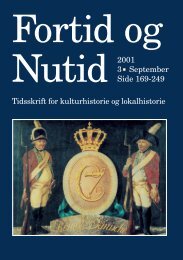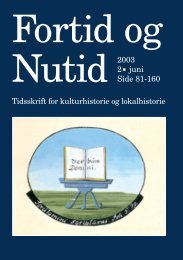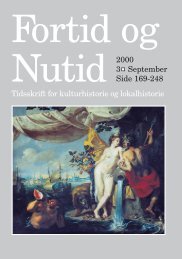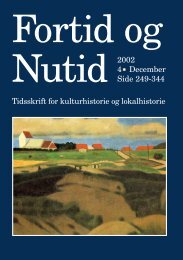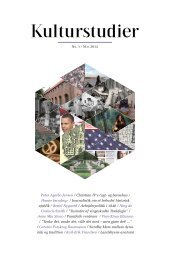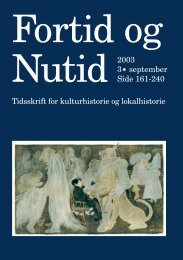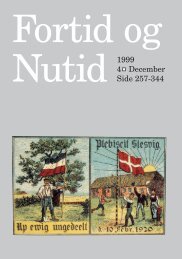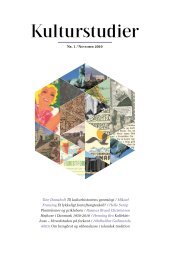Læs hele tidsskriftet (PDF) - Kulturstudier
Læs hele tidsskriftet (PDF) - Kulturstudier
Læs hele tidsskriftet (PDF) - Kulturstudier
Create successful ePaper yourself
Turn your PDF publications into a flip-book with our unique Google optimized e-Paper software.
<strong>Kulturstudier</strong> Nr. 2, 2011 The reconfigured body 13/15<br />
Concluding thoughts<br />
Animals perceived as biotechnological matter are in many different ways challenging<br />
the relationship between human and animal. The xenotransplantation<br />
research in the 1990s is only one example, but one that gives us many different<br />
perspectives on how to understand the challenges faced by dualism. Three issues<br />
have been pointed out in the article: the use of pigs in xenotransplantation,<br />
transgenic and cloned pigs, and the risk for retrovirus. Vital for the two first issues<br />
is a research and commodification process, where the reconfiguration of<br />
the animal body is made possible by using the bodily objects as cells, tissue and<br />
organ donors. The pig as biotechnological matter reconfigures both the human<br />
and the animal body, and it seems that a more boundless body appears among the<br />
researchers and biotechnological companies. Creative possibilities can be found<br />
in this boundless body as well, and new medical treatments can emerge. The<br />
third issue relates to a boundless body, but in contrast to the promising prospects<br />
of supplies for medical treatment the transgressive body would now become a<br />
threat. In the 1990s the researchers could not control the retrovirus and this risk<br />
hindered the development of xenotransplantation. Analysing the process from<br />
three different perspectives, it is central to see how the reconfiguration of objects<br />
is an on-going cultural process that questions our perspectives on what is ontologically<br />
a human/animal body. This biological process is not entirely social in its<br />
nature, but also cultural. When the biological entities are questioned and actually<br />
transformed, new body objects emerge.<br />
* The author would like to thank the reviewer for the comments that helped to<br />
improve the manuscript. Thanks also to Anne Leonora Blaakilde, Aske Juul Lassen,<br />
Monica Libell, Niclas Hagen, Åsa Alftberg, Andrea Landström and Teresa<br />
Landström for insightful comments on previous manuscripts.<br />
references<br />
Aftonbladet 09.12.1995: “Grisen ska ge dig längre liv” [Transl: The pig will give<br />
you longer life]. Article by Lotta Reberg.<br />
Berg, Marc & Stefan Timmermans, 2000: “Orders and Their Others: On the Constitution<br />
of Universalities in Medical Work”. Configurations, Vol 8:1, p. 31-61.<br />
Birke, Lynda 1999: Feminism and the Biological Body. Edinburgh University<br />
Press.<br />
Bowen, Leslie Maria 2005: “Reconfigured bodies: the problem of ownership”.<br />
Communication Theory, Vol 15:1, p. 23-38.<br />
Butler, Judith 2004: Precarious Life. The Powers of Mourning and Violence.<br />
154



